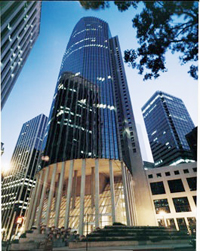Hines Releases Firm’s First Ever Sustainability Report
 HOUSTON — Hines, a privately held international real estate firm recently announced its first ever sustainability report. The report provides a detailed view of Hines’ environmental, social and governance performance, compiled in accordance with the Global Reporting Initiative (GRI).
HOUSTON — Hines, a privately held international real estate firm recently announced its first ever sustainability report. The report provides a detailed view of Hines’ environmental, social and governance performance, compiled in accordance with the Global Reporting Initiative (GRI).
Hines is no stranger to green buildings. As of Dec. 31, 2011, Hines has 403 green certified buildings worldwide, including 177 Energy Star-labeled buildings and 189 LEED certified or registered assets.
“Sustainability has been a focus of the firm for more than 50 years, and now has an expanded meaning that incorporates not only environmental issues but also social and governance policies and procedures,” said Hines president and CEO Jeff Hines in a statement. “Our sustainability program is constantly evolving, and our inaugural sustainability report communicates our current initiatives in these areas, as well as our long-term commitment to sustainability.”
The report highlights the company’s commitment to sustainable buildings, which includes everything from the design process, to the construction, to the materials being used. The process starts with a conceptual construction group that coordinates and directs all aspects of the design process, contractor and subcontracting bidding negotiations, according to the report. The report also claims that a new building design incorporating Hines-standard best practices can typically achieve LEED Gold standards.
Hines has been involved in monumental green building projects including 1180 Peachtree Tower in Atlanta, the first high-rise office building in the world to be pre-certified LEED Silver in 2005. In 2011 the company was also involved in 101 California, a 48-story tower in San Francisco with office space, which achieved LEED Platinum certification as well as the highest score ever awarded in the Existing Building (EB) category throughout the world.
In addition to strategic and environmentally friendly building designs and materials, Hines is also implementing green programs in its LEED buildings. In 2008, Hines implemented a green office program called HinesGO, as an internal program to measure and reward sustainable practices within all Hines offices worldwide, according to the report.
Hines provides facility management services for Coca-Cola’s 91,000-square-foot Brazilian headquarters and 50,000-square-foot laboratory space in Rio de Janerio, where both facilities are involved in HinesGO. Once involved in the program the facilities shifted to an open floor plan to improve flexibility and efficiency in the office space; implemented an e-waste program to recycle and donate end-of-life electronics; installed occupancy light sensors and energy-efficient, low-mercury lighting; and enacted a green-meeting policy to use videoconferencing and teleconferencing whenever possible, according to the report. This resulted in 100 percent reliance on post-consumer content recycled copier and printer paper, 80 percent Energy Star compliance for electronic equipment and more than 50 percent of waste material recycled from the facilities.
Hines buildings are located in cities throughout the world, some of which are in heavily congested areas, making parking difficult for many employees. Hines has extended sustainability to the parking garage by working on guidelines for sustainability in garage construction and management as well as certification programs for garages and personnel, according to the report. The report also mentions the installation of electric vehicle (EV) charging stations as well as automated cashiers in some building lobbies to remove visitor transactions from drive lanes, eliminating vehicle idle times at cashier stations.
Another parking initiative that saved energy for the building was 717 Texas in Houston. The building has a 12-floor parking garage that was operating lights 24 hours a day. To save electricity, the building engineers experimented with occupancy sensors for each floor and they found that a combination of 20 sensors effectively covered an entire garage level. After a month the team was able to record energy savings and now implements similar programs in buildings owned by Hines. A total of $4,875 was invested into the pilot program with an average payback of 7-15 months, and a total of 604.5 hours of lighting saved over the test period, according to the report.
Sustainable initiatives have been adopted throughout Hines’ many buildings, making them a true example of green building and green practices.
“Efficiency is more a professional commitment by our property managers and engineers than a specific short-duration program,” said Clayton Ulrich, senior vice president of corporate engineering at Hines. “Our operations teams are constantly adjusting building systems to match evolving tenant requirements, technologies and regulations. Our goal is to create an environment that supports our tenants’ business objectives while minimizing the environmental impact and operating costs of our properties.”
